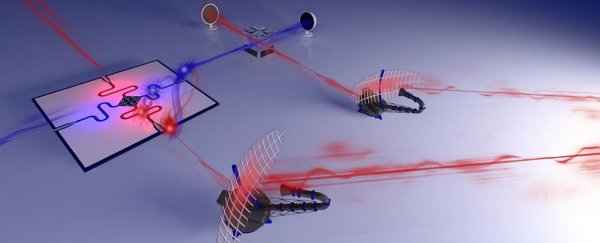Quantum entanglement – that strange but potentially hugely useful quantum phenomenon where two particles are inextricably linked across space and time – could play a major role in future radar technology.
In 2008, an engineer from MIT devised a way to use the features of entanglement to illuminate objects while using barely any photons. In certain scenarios, such technology promises to outperform conventional radar, according to its makers, particularly in noisy thermal environments.
Now, researchers have taken the idea much further, demonstrating its potential with a working prototype.
The technology might eventually find a variety of applications in security and biomedical fields: building better MRI scanners, for example, or giving doctors an alternative way of looking for particular types of cancer.
"What we have demonstrated is a proof of concept for microwave quantum radar," says quantum physicist Shabir Barzanjeh, who conducted the work at the Institute of Science and Technology Austria.
"Using entanglement generated at a few thousandths of a degree above absolute zero, we have been able to detect low reflectivity objects at room temperature."
The device works along the same principles as a normal radar, except instead of sending out radio waves to scan an area, it uses pairs of entangled photons.
Entangled particles are distinguished by having properties that correlate with one another more than you'd expect by chance. In the case of the radar, one photon from each entangled pair, described as a signal photon, is sent towards an object. The remaining photon, described as an idler, is kept in isolation, waiting for a report back.
If the signal photon reflects from an object and is caught, it can be combined with the idler to create a signature pattern of interference, setting the signal apart from other random noise.
As the signal photons reflect from an object, this actually breaks the quantum entanglement in the truest sense. This latest research verifies that even when entanglement is broken, enough information can survive to identify it as a reflected signal.
It doesn't use much power, and the radar itself is difficult to detect, which has benefits for security applications. The biggest advantage this has over conventional radar, however, is that it's less troubled by background radiation noise, which affects the sensitivity and the accuracy of standard radar hardware.
"The main message behind our research is that quantum radar or quantum microwave illumination is not only possible in theory but also in practice," says Barzanjeh.
"When benchmarked against classical low-power detectors in the same conditions we already see, at very low-signal photon numbers, that quantum-enhanced detection can be superior."
There's plenty of exciting potential here, though we shouldn't get ahead of ourselves just yet. Quantum entanglement remains an incredibly delicate process to manage, and entangling the photons initially requires a very precise and ultra-cold environment.
Barzanjeh and his colleagues are continuing their development of the quantum radar idea, yet another sign of how quantum physics is likely to transform our technologies in the near future – in everything from communications to supercomputing.
"Throughout history, proof of concepts such as the one we have demonstrated here have often served as prominent milestones towards future technological advancements," says Barzanjeh.
"It will be interesting to see the future implications of this research, particularly for short-range microwave sensors."
The research has been published in Science Advances.
